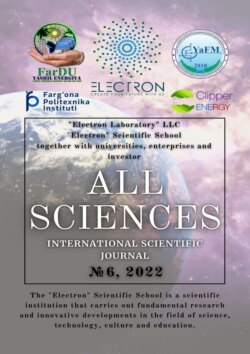Читать книгу All sciences. №6, 2022. International Scientific Journal - Ibratjon Xatamovich Aliyev - Страница 5
PHYSICAL SCIENCES
SPATIALLY OSCILLATING PHOTOVOLTAIC CURRENT IN AN OPTICALLY ACTIVE FERROELECTRIC SbSI
Ferghana State University, Ferghana, Uzbekistan
ОглавлениеАннотация. В настоящей работе обнаружен и исследованы пространственно-осциллирующей фотовольтаический ток (ПОФТ) в направлении [100] в сегнетоэлектрике SbSJ при освещении поляризованным светом в направлении [010] и образованию от оптической зависимости в [001] направлении структуры пространственного осциллирующего фотовольтаического тока Jx. Обсуждены некоторые экспериментальные и физические основы пространственно осциллирующего фотовольтаического тока.
Ключевые слова: сегнетоэлектрик, поляризация, оптически-активный кристалл, пространственно-осциллирующий фотовольтаический ток, тензор 3-ранга.
Annotation. In this paper, the spatially oscillating photovoltaic current (POFT) in the direction [100] in the SbSJ ferroelectric is detected and investigated when illuminated with polarized light in the direction [010] and the formation of the structure of the spatial oscillating photovoltaic current Jx from the optical dependence in the direction [001]. Some experimental and physical bases of spatially oscillating photovoltaic current are discussed.
Keywords: ferroelectric, polarization, optically active crystal, spatially oscillating photovoltaic current, rank 3 tensor.
In recent years, it has become clear that in thermodynamic nonequilibrium conditions, currents of a different nature are possible due to the absence of a center of symmetry medium. The most important of this class of effect is the anomalous photovoltaic effect (AF effect).
The AF effect is that with uniform illumination of a short-circuited ferroelectric, a stationary current flows through it, which in [1,2] was called photovoltaic. It has been shown that it is the photovoltaic current that leads to the anomalous photovoltaic effect (AF effect) in ferroelectrics.
The anomalous photovoltaic effect discovered for ferroelectrics for the first time in [1,2] is a special case of a more general AF effect described for crystals without a center of symmetry by the third rank aijk tensor [3].
According to (1), with uniform illumination by linearly polarized light of homogeneous crystals without a center of symmetry (ferroelectric or piezoelectric crystal), a photovoltaic current Ji arises in it, the sign and magnitude of which depend on the orientation of the polarization vector of light with projections Ej, Ek*.
The components of the aijk tensor are nonzero for 20 acentric symmetry groups. If the electrodes of the crystal are opened, the photovoltaic current Ji generates photovoltaic voltages
where σt and σf, respectively, are the dark and photoconductivity, l is the distance between the electrodes. The generated photovoltage is of the order of 103—105 V, thus exceeding the value of the band gap Eg by two to four orders of magnitude.
In accordance with (1) and the symmetry of the point group of the crystal, expressions can be written for the photovoltaic current Ji. Comparison of the experimental angular dependence of Ji (β) with (1) makes it possible to determine the photovoltaic tensor aijk or photovoltaic coefficient
a* is the light absorption coefficient.
As shown by Belinicher [4], depending on the shape of the optical indicatrix and the direction of propagation of plane polarized light in the crystal, there may be directions for which the photovoltaic current (1) is spatially oscillating. In this case:
where ne, n0 are the refractive indices of ordinary and extraordinary rays, Ee and E0* are the projections of the polarization vector of light on the optical axes of the crystal,
In this case, the photovoltaic current (2) oscillates in the crystal with a period of
As indicated in [4] and as can be seen from (2), a spatially oscillating photovoltaic current (SWEAT) can be experimentally observed under conditions of strong light absorption.
where α* is the absorption coefficient.
